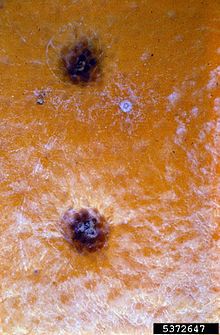Phyllosticta citricarpa
| Citrus Black Spot | |
|---|---|

Citrus Black Spot lesions
|
|
| Causal agents | Phyllosticta citricarpa |
| Hosts | Citrus |
| EPPO Code | GUIGCI |
| Guignardia citricarpa | |
|---|---|
| Scientific classification | |
| Kingdom: | Fungi |
| Phylum: | Ascomycota |
| Class: | Dothideomycetes |
| Subclass: | Incertae sedis |
| Order: | Botryosphaeriales |
| Family: | Botryosphaeriaceae |
| Genus: | Guignardia |
| Species: | G. citricarpa |
| Binomial name | |
|
Guignardia citricarpa Kiely, (1948) |
|
| Synonyms | |
|
Phoma citricarpa McAlpine, (1899) |
|
Citrus Black Spot is a fungal disease caused by Guignardia citricarpa. This Ascomycete fungus affects citrus plants throughout subtropical climates, causing a reduction in both fruit quantity and quality. Symptoms include both fruit and leaf lesions, the latter being critical to inter-tree dispersal. Strict regulation and management is necessary to control this disease since there are currently no citrus varieties that are resistant.
Phoma citricarpa McAlpine, (1899)
Phoma citricarpa var. mikan Hara
Phyllosticta citricarpa (McAlpine) Aa, (1973)
Phyllostictina citricarpa (McAlpine) Petr., (1953)
Guignardia citricarpa is a plant pathogen, some strains of which cause a leaf condition called black spot on citrus plants. As a result, such strains are subject to phytosanitary legislation in the European Union and the United States.
Metabolite secreted by G. citricarpa have an inhibitory growth effect on some endophytic bacterial species, and stimulatory growth effect on others.
An isolate of G. citricarpa was found to produce the medically important compound, taxol under certain growth conditions.
Citrus Black Spot was first found in Sydney, Australia in 1879 and then appeared in South Africa along the coast of Natal in 1929. It can be found in many countries around the world. These countries include: Argentina, Australia, Brazil, China, Ghana, Mozambique, Philippines, South Africa, Sub-Saharan Africa, Taiwan, The United States and Uruguay. Whether or not Citrus Black Spot is present in Japan and New Zealand is controversial. In both countries the fungus was thought to have been found, but after further testing it was identified as the non-pathogenic strain, Guignardia mangiferae, rather than the pathogenic strain Guignardia citricarpa which causes Citrus Black Spot. This disease is relatively new to North America; it was first seen in Southern Florida March, 2010. Though Florida has taken measures to try to control this disease it is expected to rapidly spread to other areas over the next few years.
...
Wikipedia
